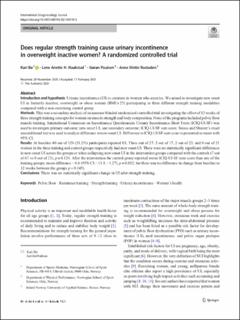| dc.contributor.author | Bø, Kari | |
| dc.contributor.author | Haakstad, Lene Annette Hagen | |
| dc.contributor.author | Paulsen, Gøran | |
| dc.contributor.author | Rustaden, Anne Mette | |
| dc.date.accessioned | 2021-06-04T17:23:30Z | |
| dc.date.available | 2021-06-04T17:23:30Z | |
| dc.date.created | 2021-04-07T14:11:37Z | |
| dc.date.issued | 2021 | |
| dc.identifier.citation | International Urogynecology Journal. 2021, Artikkel 04739-5. | en_US |
| dc.identifier.issn | 0937-3462 | |
| dc.identifier.uri | https://hdl.handle.net/11250/2758006 | |
| dc.description | This article is licensed under a Creative Commons Attribution 4.0 International License, which permits use, sharing, adaptation, distribution and reproduction in any medium or format, as long as you give appropriate credit to the original author(s) and the source, provide a link to the Creative Commons licence, and indicate if changes were made. The images or other third party material in this article are included in the article's Creative Commons licence, unless indicated otherwise in a credit line to the material. If material is not included in the article's Creative Commons licence and your intended use is not permitted by statutory regulation or exceeds the permitted use, you will need to obtain permission directly from the copyright holder. | en_US |
| dc.description.abstract | Introduction and hypothesis: Urinary incontinence (UI) is common in women who exercise. We aimed to investigate new onset UI in formerly inactive, overweight or obese women (BMI > 25) participating in three different strength training modalities compared with a non-exercising control group.
Methods: This was a secondary analysis of an assessor blinded randomized controlled trial investigating the effect of 12 weeks of three strength training concepts for women on muscle strength and body composition. None of the programs included pelvic floor muscle training. International Consensus on Incontinence Questionnaire Urinary Incontinence Short Form (ICIQ-UI-SF) was used to investigate primary outcome; new onset UI, and secondary outcome; ICIQ-UI-SF sum score. Suissa and Shuster’s exact unconditional test was used to analyze difference in new onset UI. Difference in ICIQ-UI-SF sum score is presented as mean with 95% CI.
Results: At baseline 40 out of 128 (31.2%) participants reported UI. Three out of 27, 2 out of 17, 2 out of 23, and 0 out of 21 women in the three training and control groups respectively had new onset UI. There were no statistically significant differences in new onset UI across the groups or when collapsing new onset UI in the intervention groups compared with the controls (7 out of 67 vs 0 out of 21), p = 0.124. After the intervention the control group reported worse ICIQ-UI-SF sum score than any of the training groups; mean difference − 6.6 (95% CI: −11.9, −1.27), p = 0.012, but there was no difference in change from baseline to 12 weeks between the groups p = 0.145).
Conclusions: There was no statistically significant change in UI after strength training. | en_US |
| dc.language.iso | eng | en_US |
| dc.subject | pelvic floor | en_US |
| dc.subject | resistance training | en_US |
| dc.subject | strength training | en_US |
| dc.subject | urinary incontinence | en_US |
| dc.subject | women's health | en_US |
| dc.title | Does regular strength training cause urinary incontinence in overweight inactive women? A randomized controlled trial | en_US |
| dc.type | Peer reviewed | en_US |
| dc.type | Journal article | en_US |
| dc.description.version | publishedVersion | en_US |
| dc.rights.holder | © The Author(s) 2021 | en_US |
| dc.source.pagenumber | 8 | en_US |
| dc.source.journal | International Urogynecology Journal | en_US |
| dc.identifier.doi | 10.1007/s00192-021-04739-5 | |
| dc.identifier.cristin | 1902748 | |
| dc.description.localcode | Institutt for idrettsmedisinske fag / Department of Sports Medicine | en_US |
| dc.source.articlenumber | 04739-5 | en_US |
| cristin.ispublished | true | |
| cristin.fulltext | original | |
| cristin.qualitycode | 1 | |
